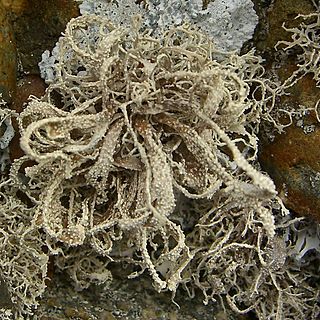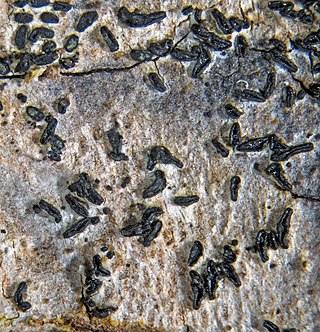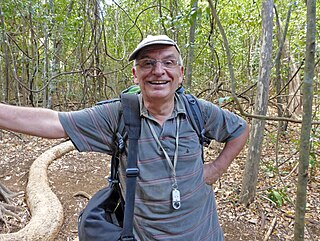
The Roccellaceae are a family of fungi in the order Arthoniomycetes. Most taxa are lichenized with green algae, although some are lichenicolous, growing on other lichens.

Porina is a genus of lichens in the family Trichotheliaceae. A 2020 estimate places about 145 species in the widespread genus.

Micarea is a genus of lichenized fungi in the family Pilocarpaceae. The widely distributed genus contains 126 species and new species are described actively. Species in the genus are crustose lichens and their photobiont is a single-celled green alga.

Dendrographa is a genus of lichen-forming fungi in the family Roccellaceae. It has seven species. It was given its current name by Otto Vernon Darbishire in 1895.

Enterographa is a genus of lichens in the family Roccellaceae.

Lecanactis is a genus of crustose lichens, commonly called old wood rimmed lichen. The genus was circumscribed in 1855 by German lichenologist Gustav Wilhelm Körber, who assigned Lecanactis abietina as the type species.

Syncesia is a genus of lichen-forming fungi in the family Roccellaceae.
Agonimia is a genus of lichen-forming fungi in the family Verrucariaceae.
Pseudopyrenula is a genus of lichen-forming fungi in the family Trypetheliaceae.
Synarthonia is a genus of lichen-forming fungi in the order Arthoniales. The genus has not been placed into a family. Synarthonia was circumscribed by Swiss lichenologist Johannes Müller Argoviensis in 1891.
André Aptroot is a Dutch mycologist and lichenologist.

Malmideaceae is a family of crustose and corticolous lichens in the order Lecanorales. It contains eight genera and about 70 species.

Alyxoria is a genus of lichen-forming fungi in the family Lecanographaceae.
Alan W. Archer is a mycologist and taxonomist. He is currently an honorary research associate at Royal Botanic Gardens Sydney. He uses chemotaxonomy as well as morphological features in taxonomy and to devise keys, most recently for the genus Pertusaria in the Australasia region.

Emmanuël Sérusiaux is a Belgian lichenologist. His career, spanning more than four decades, has combined both lichenology research and political aspects of nature conservation. He spent several periods working as a researcher at the National Fund for Scientific Research and the University of Liège, the latter in which he accepted a faculty position as professor and head of the Plant Taxonomy and Conservation Biology unit. Sérusiaux also served for three non-consecutive appointments as Deputy Chief of Staff in the Government of Wallonia. He retired from both his academic and political positions in 2019.
Savoronala is a fungal genus in the family Malmideaceae. It is monotypic, containing the single species Savoronala madagascariensis. This lichen produces unique conidia that each include a single algal cell.
Syncesia afromontana is a rare species of byssoid lichen in the family Roccellaceae. Found in Rwanda, it was formally described as a new species in 2010 by Damien Ertz, Dorothee Killmann, Emmanuël Sérusiaux, and Eberhard Fischer. The type specimen was collected in the Rwasenkoko swamp area of Nyungwe National Park at an altitude of 2,335 m (7,661 ft). It is only known to occur at the type locality, where it grows on the trunks of Erica in thickets of Erica johnstonii as well as in forests of Hagenia abyssinica and Rapanea melanophloeios. The lichen has a byssoid, water-repellent thallus that is greyish to greyish-green and up to 10 cm (4 in) in diameter. It contains protocetraric acid as a major metabolite, and trace amounts of roccellic acid.
Isalonactis is a monotypic fungal genus in the family Roccellaceae. It contains the single species Isalonactis madagascariensis, a saxicolous (rock-dwelling), crustose lichen found in Madagascar. Both the genus and species were described as new in 2014 by Damien Ertz, Anders Tehler, Eberhard Fischer, Dorothee Killmann, Tahina Razafindrahaja, and Emmanuël Sérusiaux. The type was collected on the Isalo Massif at an altitude of 851 m (2,792 ft); there, it was found growing on sheltered mesozoic sandstone cliffs. The genus name alludes to both Isalo Massif, the type locality, and the phylogenetic relatedness to genus Lecanactis.
Aspidothelium is a genus of lichen-forming fungi in the family Thelenellaceae. All species in the genus have a tropical distribution and are crustose with a chlorococcoid photobiont partner. Most Aspidothelium species are foliicolous (leaf-dwelling), although some corticolous (bark-dwelling) species are known, as well as a single saxicolous (rock-dwelling) member.
Dirina madagascariensis is a species of crustose lichen in the family Roccellaceae. Found in southern Madagascar, it was formally described as a new species in 2013 by lichenologists Anders Tehler, Damien Ertz, Dorothee Killmann, Tahina Razafindrahaja, Emmanuël Sérusiaux, and Eberhard Fischer. The type specimen was collected by the second author from Taolagnaro (Fort-Dauphin). It has been recorded growing both on rocks and on the bark of various trees and shrubs. The lichen has a creamy white to white-greyish thallus with a chalk-like medulla. Its ascospores measure 25–35 by 4–5 μm. D. madagascariensis contains the lichen products erythrin, lecanoric acid, and the unidentified substances named "C" and "J"; it is this latter substance that is characteristic of this species.










